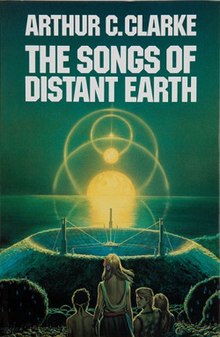The Songs of Distant Earth

Cover of the first US edition
|
|
| Author | Arthur C. Clarke |
|---|---|
| Cover artist | Michael Whelan |
| Country | United Kingdom |
| Language | English |
| Genre | Science fiction |
| Publisher |
Grafton Books (UK) Del Rey Books (US) |
|
Publication date
|
1986 |
| Media type | Print (Hardcover) |
| Pages | 256 pp |
| ISBN | |
| OCLC | 12807679 |
| 823/.914 19 | |
| LC Class | PR6005.L36 S66 1986 |
The Songs of Distant Earth is a 1986 science fiction novel by Arthur C. Clarke based upon his 1958 short story of the same title. He stated that it was his favourite of all his novels. Clarke also wrote a short movie synopsis with the same title, published in Omni magazine and anthologized in The Sentinel in 1983.
The novel tells of a utopian human colony in the far future that is visited by travellers from a doomed Earth, as the Sun has gone nova. The Songs of Distant Earth explores apocalyptic, atheistic, and utopian ideas, as well as the effects of long-term interstellar travel and extra-terrestrial life.
Gerald Jones of The New York Times gave the novel a positive review, praising its scope and its exploration of philosophical dilemmas: "The drama that interests Mr. Clarke is played out on a much larger canvas. It concerns the lures and limitations of knowledge, the destiny of mankind, and the fate of the universe."
The novel is set in the early 3800s and takes place almost entirely on the faraway oceanic planet of Thalassa. Thalassa has a small human population sent there by way of an embryonic seed pod, one of many sent out from Earth in an attempt to continue the human race before the Earth was destroyed.
The story begins with an introduction to the native Thalassans – the marine biologist Brant, his partner Mirissa and her brother Kumar. They are typical examples of the Thalassan culture; quiet, stable and free from religion and supernatural influence. Their peaceful existence comes to an end with the arrival of the Magellan, an interstellar spaceship from Earth containing one million colonists who have been put into cryonic suspension.
In a series of descriptive passages, the events leading up to the race to save the human species are explained. Scientists in the 1960s discover that the neutrino emissions from the Sun – a result of the nuclear reactions that fuel the star – are far diminished from expected levels. At a secret session of the International Astronomical Union it is confirmed that the problem is not with the scientific equipment: the Sun is calculated to become a nova around the year AD 3600.
...
Wikipedia
